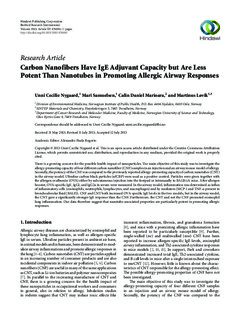| dc.contributor.author | Nygaard, Unni Cecilie | |
| dc.contributor.author | Samuelsen, Mari | |
| dc.contributor.author | Marioara, Calin Daniel | |
| dc.contributor.author | Løvik, Martinus | |
| dc.date.accessioned | 2020-02-07T08:58:34Z | |
| dc.date.available | 2020-02-07T08:58:34Z | |
| dc.date.created | 2013-10-22T09:56:09Z | |
| dc.date.issued | 2013 | |
| dc.identifier.citation | BioMed Research International. 2013, 2013 . | nb_NO |
| dc.identifier.issn | 2314-6133 | |
| dc.identifier.uri | http://hdl.handle.net/11250/2640185 | |
| dc.description.abstract | There is a growing concern for the possible health impact of nanoparticles. The main objective of this study was to investigate the allergy-promoting capacity of four different carbon nanofiber (CNF) samples in an injection and an airway mouse model of allergy. Secondly, the potency of the CNF was compared to the previously reported allergy-promoting capacity of carbon nanotubes (CNT) in the airway model. Ultrafine carbon black particles (ufCBP) were used as a positive control. Particles were given together with the allergen ovalbumin (OVA) either by subcutaneous injection into the footpad or intranasally to BALB/cA mice. After allergen booster, OVA-specific IgE, IgG1, and IgG2a in serum were measured. In the airway model, inflammation was determined as influx of inflammatory cells (eosinophils, neutrophils, lymphocytes, and macrophages) and by mediators (MCP-1 and TNF- present in bronchoalveolar fluid (BALF)). CNF and CNT both increased OVA-specific IgE levels in the two models, but in the airway model, the CNT gave a significantly stronger IgE response than the CNF. Furthermore, the CNT and not the CNF promoted eosinophil lung inflammation. Our data therefore suggest that nanotube-associated properties are particularly potent in promoting allergic responses. | nb_NO |
| dc.language.iso | eng | nb_NO |
| dc.publisher | Hindawi | nb_NO |
| dc.relation.uri | http://www.hindawi.com/journals/bmri/2013/476010/ | |
| dc.rights | Navngivelse 4.0 Internasjonal | * |
| dc.rights.uri | http://creativecommons.org/licenses/by/4.0/deed.no | * |
| dc.subject | Nanoparticles | nb_NO |
| dc.subject | Carbon nanofibers | nb_NO |
| dc.subject | Allergies | nb_NO |
| dc.title | Carbon nanofibers have IgE adjuvant capacity but are less potent than nanotubes in promoting allergic airway responses | nb_NO |
| dc.type | Journal article | nb_NO |
| dc.type | Peer reviewed | nb_NO |
| dc.description.version | publishedVersion | nb_NO |
| dc.rights.holder | Copyright © 2013 Unni Cecilie Nygaard et al. This is an open access article distributed under the Creative Commons Attribution License, which permits unrestricted use, distribution, and reproduction in any medium, provided the original work is properly cited. | nb_NO |
| dc.subject.nsi | VDP::Medisinsk immunologi: 716 | nb_NO |
| dc.subject.nsi | VDP::Medical immunology: 716 | nb_NO |
| dc.source.pagenumber | 12 | nb_NO |
| dc.source.volume | 2013 | nb_NO |
| dc.source.journal | BioMed Research International | nb_NO |
| dc.identifier.doi | 10.1155/2013/476010 | |
| dc.identifier.cristin | 1059373 | |
| cristin.unitcode | 7401,80,64,0 | |
| cristin.unitname | Materialer og nanoteknologi | |
| cristin.ispublished | true | |
| cristin.fulltext | original | |
| cristin.qualitycode | 1 | |

